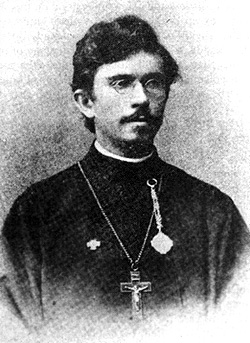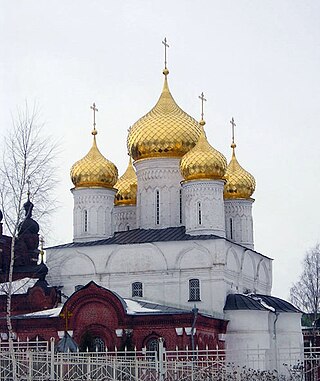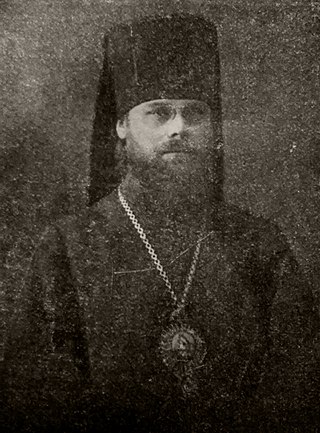
August 7 - Eastern Orthodox liturgical calendar - August 9
Nicodemus was a Pharisee who showed favor to Jesus.

Vladimir, baptismal name: Vasily Nikiforovich Bogoyavlensky, was a bishop of the Russian Orthodox Church. He was appointed the position of Metropolitan of Moscow and Kolomna between 1898 and 1912, Metropolitan of St. Petersburg and Ladoga between 1912 and 1915, and the Metropolitan of Kiev and Galicia between 1915 and 1918. Murdered by Bolshevik soldiers in 1918, Metropolitan Vladimir was glorified as a Hieromartyr by the Russian Orthodox Church in 1992.

The Ukrainian Orthodox Church of the USA is a jurisdiction of the Ecumenical Patriarchate in the United States. It consists of two eparchies (dioceses), ruled by two bishops, including about 85 active parishes and missions. The Church's current leader is Metropolitan Antony. The Church's head offices and Consistory are based in South Bound Brook, New Jersey.

Metropolitan Yurij (Kalistchuk) of Winnipeg and Canada, born George Kalistchuk in Lachine, Quebec, on May 26, 1951, is the current primate of the autonomous Ukrainian Orthodox Church of Canada.

Alexander Hotovitzky (1872-1937) was a Russian Orthodox hieromartyr.

The Archeparchy of Lviv is an ecclesiastical territory or ecclesiastical province of the Ukrainian Greek Catholic Church — a particular Eastern Catholic Church, that is located in Ukraine. It was erected in 1807. As a metropolitan see, it has three suffragan sees: Stryi, Sambir-Drohobych, and Sokal–Zhovkva. The incumbent Metropolitan Archbishop is Ihor Vozniak. The cathedral church of the archeparchy is St. George's in the city of Lviv.

The Ukrainian Catholic Archeparchy of Przemyśl–Warsaw is an ecclesiastical territory or ecclesiastical province of the Ukrainian Greek Catholic Church — a particular Eastern Catholic Church, that is located in the south-eastern part of Poland. It was erected in 1996. Its Byzantine Rite services are conducted in the Ukrainian language. As a metropolitan see, it has two suffragan sees: Olsztyn–Gdańsk and Wrocław-Koszalin. The incumbent ordinary of the archeparchy is Eugeniusz Popowicz. It is assisted and protected by the Dicastery for the Eastern Churches in Rome. The cathedral church of the archeparchy is the Cathedral of St. John the Baptist, in the city of Przemyśl. Although the national capital of Warsaw was added to its title, there is no co-cathedral.

Archbishop Joachim of Nizhny Novgorod (born Ivan Ioakimovich Levitsky (Russian: Иван Акимович Леви́цкий,, was a Russian Orthodox bishop and religious writer allegedly martyred by local Bolsheviks by being crucified upside down on the royal doors of the iconostasis in St. Vladimir's Cathedral in Sevastopol. The exact date of his death is unclear, with dates ranging from 1918 to 1920 or even to "not later than April 1921" in various sources, and he is sometimes said merely to have "died at the hands of unknown bandits".

Metropolitan Anthony was a bishop of the Russian Orthodox Church in the Russian Empire, the Metropolitan of Kiev and Galicia, who after the defeat of Gen Pyotr Wrangel's White Army in South Russia in November 1920 emigrated and in 1921 settled down in Sremski Karlovci, Serbia. He, along with several other Russian bishops in exile, established an independent Russian church administration that sought to embrace all Russian Orthodox diaspora, known as the Russian Orthodox Church Outside Russia (ROCOR).

The Saint Petersburg Theological Academy is a higher education institution of the Russian Orthodox Church, located in Saint Petersburg, Russia. The academy preparing theologians, clergymen, singers and icon writers for the Eastern Orthodox Church and grants bachelor, master, candidate and doctorate degrees. It was founded in 1797 by Metropolitan Gabriel (Petrov) of Saint Petersburg, as part of the Alexander Nevsky Lavra.

Andriy Peshko is the Bishop of Toronto and of the Eastern Eparchy of the Ukrainian Orthodox Church of Canada.

The Kostroma Diocese is an eparchy of the Russian Orthodox Church in Russia. It combines parishes and monasteries within the Kostroma Oblast while the eparchial center lies in Kostroma. The former eparchy's cathedral was the Assumption Cathedral in Kostroma while the current cathedrals include the Cathedrals of the Epiphany, St. Anastasia Monastery in Kostroma, and Galich Vvedensky.

Valdomiro Koubetch, O.S.B.M. is the Archbishop-Metropolitan of the Ukrainian Catholic Archeparchy of São João Batista em Curitiba.
The Archeparchy of Polotsk-Vitebsk was an archeparchy of the Ruthenian Uniate Church that was situated in the Polish–Lithuanian Commonwealth. From 1596 to 1839, it was a suffragan eparchy of the Metropolis of Kiev, Galicia and all Ruthenia. The cathedral church of the archeparchy was Cathedral of Saint Sophia in the city of Polotsk.

Metropolitan Dionysius was the Metropolitan of Warsaw and all Poland and the primate of the Polish Orthodox Church from 27 February 1923 to 17 April 1948.

Nicodemus is a masculine given name of Greek origin meaning “victory of the people.” Nicodemus is a Biblical figure. Nikodem, a Croatian and Polish version of the name, was among the most popular names for newborn boys in Poland in 2022.
The Metropolis of Kiev, Galicia and all Rus' was a metropolis of the Ecumenical Patriarchate of Constantinople in the Eastern Orthodox Church that was erected in 1620. The dioceses (eparchies) included the Eparchy of Kiev itself, along with the eparchies of Lutsk, Lviv, Mahilioŭ, Przemyśl, Polatsk, and Chernihiv. The dioceses lay in the territory of the Polish–Lithuanian Commonwealth, which was at war with the Tsardom of Moscow for much of the 17th century. Around 1686, the Kiev and Chernihiv dioceses became Moscow-controlled territory. At the same time, the metropolis transferred from the ecclesiastical jurisdiction of the Ecumenical Patriarchate of Constantinople to the Patriarchate of Moscow in 1686. It is a matter of dispute as to whether this de facto transfer was also de jure or canonical.

Metropolitan Aleksandr was a bishop of the Polish Orthodox Church and Ukrainian Autocephalous Orthodox Church.
















